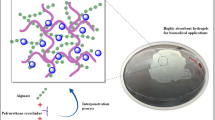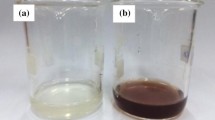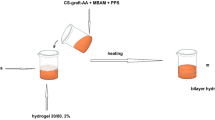Abstract
The purpose of this study was to investigate the effect of combined Ca2+ cross-linking and freeze-thawing cycle method on metronidazole (model drug) drug release and prepare a wound film dressing with improved swelling property. The hydrogel films were prepared with sodium alginate (SA) using the freeze-thawing method alone or in combination with ionotropic gelation with CaCl2. The gel properties such as morphology, swelling, film thickness, and content uniformity and in vitro dissolution profiles using Franz diffusion cell were investigated. The cross-linking process was confirmed by differential scanning calorimetry (DSC) and Fourier transform infrared (FTIR) spectroscopy. In vitro protein adsorption test, in vivo wound-healing test, and histopathology were also performed. The hydrogel (F2) composed of 6% sodium alginate and 1% metronidazole prepared by combined Ca2+ cross-linking and freeze-thawing cycles showed good swelling. This will help to provide moist environment at the wound site. With the in vivo wound-healing and histological studies, F2 was found to improve the wound-healing effect compared with the hydrogel without the drug, and the conventional product.








Similar content being viewed by others
REFERENCES
U.S. Department of Health and Human Services: Wounds. 2013. http://www.nlm.nih.gov/medlineplus/wounds.html. Accessed 28 Nov 2013.
Hinman CD, Maibach H. Effect of air exposure and occlusion on experimental human skin wounds. Nat. 1963;200(26):377–8.
Lipsky BA, Hoey C. Topical antimicrobial therapy for treating chronic wounds. Clin Infect Dis. 2009;49(10):1541–9. doi:10.1086/644732.
Vowden P, Cooper R. An integrated approach to managing wound infection. EWMA Position Document: management of wound infection. 2006. 2–6.
Bowler PG, Duerden BI, Armstrong DG. Wound microbiology and associated approaches to wound management. Clin Microbiol Rev. 2001;14(2):244–69.
Pawar HV, Tetteh J, Boateng JS. Preparation, optimisation and characterisation of novel wound healing film dressings loaded with streptomycin and diclofenac. Colloids Surf B: Biointerfaces. 2013;102:102–10. doi:10.1016/j.colsurfb.2012.08.014.
Winter GD. Formation of the scab and the rate of epithelization of superficial wounds in the skin of the young domestic pig. Nat. 1962;193:293–4.
Ajji Z, Mirjalili G, Alkhatab A, Dada H. Use of electron beam for the production of hydrogel dressings. Rad Phys Chem. 2008;77(2):200–2. doi:10.1016/j.radphyschem.2007.05.016.
Hoffman AS. Hydrogels for biomedical applications. Adv Drug Deliv Rev. 2002;54(1):3–12.
Morin RJ, Tomaselli NL. Interactive dressings and topical agents. Clin Plast Surg. 2007;34(4):643–58.
Gilchrist T, Martin AM. Wound treatment with Sorbsan—an alginate fibre dressing. Biomaterials. 1983;4(4):317–20.
Läuchli S, Hafner J, Ostheeren S, Mayer D, Barysch MJ, French LE. Management of split-thickness skin graft donor sites: a randomized controlled trial of calcium alginate versus polyurethane film dressing. Dermatol. 2013;227(4):361–6. doi:10.1159/000356122.
Hassan CM, Stewart JE, Peppas NA. Diffusional characteristics of freeze/thawed poly(vinyl alcohol) hydrogels: applications to protein controlled release from multilaminate devices. Eur J Pharm Biopharm. 2000;49(2):161–5.
Pillay V, Dangor CM, Govender T, Moopanar KR, Hurbans N. Ionotropic gelation: encapsulation of indomethacin in calcium alginate gel discs. J Microencapsul. 1998;15(2):215–26.
Hua S, Ma H, Li X, Yang H, Wang A. pH-sensitive sodium alginate/poly (vinyl alcohol) hydrogel beads prepared by combined Ca2+ crosslinking and freeze-thawing cycles for controlled release of diclofenac sodium. Int J Biol Macromol. 2010;46(5):517–23. doi:10.1016/j.ijbiomac.2010.03.004.
Xing L, Dawei C, Liping X, Rongqing Z. Oral colon-specific drug delivery for bee venom peptide: development of a coated calcium alginate gel beads-entrapped liposome. J Control Release. 2003;93(3):293–300.
Tsukada K, Tokunaga K, Iwama T, Mishima Y. The pH changes of pressure ulcers related to the healing process of wounds. Wounds. 1992;4(1):16–20.
Boateng JS, Pawar HV, Tetteh J. Polyox and carrageenan based composite film dressing containing anti-microbial and anti-inflammatory drugs for effective wound healing. Int J Pharm. 2013;441(1–2):181–91. doi:10.1016/j.ijpharm.2012.11.045.
Pawar HV, Boateng JS, Ayensu I, Tetteh J. Multifunctional medicated lyophilised wafer dressing for effective chronic wound healing. J Pharm Sci. 2014;103(6):1720–33. doi:10.1002/jps.23968.
Labovitiadi O, Lamb AJ, Matthews KH. In vitro efficacy of antimicrobial wafers against methicillin-resistant Staphylococcus aureus. Ther Deliv. 2012;3(4):443–55.
Paul JC, Pieper BA. Topical metronidazole for the treatment of wound odor: a review of the literature. Ostomy Wound Manag. 2008;54(3):18–27. quiz 28–9.
Rao CM, George KM, Bairy KL. An appraisal of the healing profiles of oral and external (GEL) metronidazole on partial thickness burn wounds. Indian J Pharmacol. 2000;32:282–7.
Trindade LC, Biondo-Simões Mde L, Sampaio CP, Farias RE, Pierin RJ, Netto MC. Evaluation of topical metronidazole in the healing wounds process: an experimental study. Rev Col Bras Cir. 2010;37(5):358–63.
Society of Toxicology (SOT): Guiding principles in the use of animals in toxicology. 2008. http://wwwwww.toxicology.org/AI/FA/guidingprinciples.pdf. Accessed 28 Nov 2013.
British Pharmacopoeia. Infrared reference spectra. London: Stationery Office; 2013.
Korsmeyer RW, Gurny R, Doelker E, Buri P, Peppas NA. Mechanisms of potassium chloride release from compressed, hydrophilic, polymeric matrices: effect of entrapped air. J Pharm Sci. 1983;72(10):1189–91.
Laohakunjit N, Noomhorm A. Effect of plasticizers on mechanical and barrier properties of rice starch film. Starch-Starke. 2004;56:348–56. doi:10.1002/star.200300249.
Deng KL, Gou YB, Dong LR, Li Q, Bai LB, Gao T, et al. Drug release behaviors of a pH/temperature sensitive core-shelled bead with alginate and poly(N-acryloyl glycinates). Front Mater Sci Chin. 2010;4(4):353–8. doi:10.1007/s11706-010-0105-1.
Peppas NA, Buri PA. Surface interfacial and molecular aspects of polymer bioadhesion on soft tissues. J Cont Rel. 1985;2:257–75. doi:10.1016/0168-3659(85)90050-1.
Kim JO, Choi JY, Park JK, Kim JH, Jin SG, Chang SW, et al. Development of clindamycin-loaded wound dressing with polyvinyl alcohol and sodium alginate. Biol Pharm Bull. 2008;31(12):2277–82.
Chandy T, Sharma CP. Changes in albumin/platelet interaction with an artificial surface—due to a antibiotics, pyridoxal phosphate, and lymphocytes. Artif Organs. 1988;12(2):143–51.
Binulal NS, Deepthy M, Selvamurugan N, Shalumon KT, Suja S, Mony U, et al. Role of nanofibrous poly(caprolactone) scaffolds in human mesenchymal stem cell attachment and spreading for in vitro bone tissue engineering—response to osteogenic regulators. Tissue Eng Part A. 2010;16(2):393–404. doi:10.1089/ten.TEA.2009.0242.
Sudheesh Kumar PT, Sowmya S, Vinoth-Kumar L, Tamura H, Nair SV, Jayakumar R. β-Chitin hydrogel/nano hydroxyapatite composite scaffolds for tissue engineering applications. Carbohydr Polym. 2011;85:584–91. doi:10.1016/j.carbpol.2011.03.018.
Pathak TS, Kim JS, Lee SJ, Baek DJ, Paeng KJ. Preparation of alginic acid and metal alginate from algae and their comparative study. J Polym Environ. 2008;16(3):198–204. doi:10.1007/s10924-008-0097-4.
Caykara T, Demirci S, Eroğlu MS, Güven O. Poly(ethylene oxide) and its blends with sodium alginate. Polym. 2005;46(24):10750–7. doi:10.1016/j.polymer.2005.09.041.
Ausili E, Paolucci V, Triarico S, Maestrini C, Murolo D, Focarelli B, et al. Treatment of pressure sores in spina bifida patients with calcium alginate and foam dressings. Eur Rev Med Pharmacol Sci. 2013;17(12):1642–7.
Nicholson TJ, Armstrong D. Topical metronidazole (10 percent) decreases posthemorrhoidectomy pain and improves healing. Dis Colon Rectum. 2004;47(5):711–6.
ACKNOWLEDGMENTS
The authors would like to thank Madonna Nady, Doha Mosamaa, Elaf Abdulkadir, Al Hanouf M. Aljabri, Farah M. Amin, and Marwa R. Shamsaldin for their assistance.
Author information
Authors and Affiliations
Corresponding author
Rights and permissions
About this article
Cite this article
Sarheed, O., Abdul Rasool, B.K., Abu-Gharbieh, E. et al. An Investigation and Characterization on Alginate Hydogel Dressing Loaded with Metronidazole Prepared by Combined Inotropic Gelation and Freeze-Thawing Cycles for Controlled Release. AAPS PharmSciTech 16, 601–609 (2015). https://doi.org/10.1208/s12249-014-0237-1
Received:
Accepted:
Published:
Issue Date:
DOI: https://doi.org/10.1208/s12249-014-0237-1




